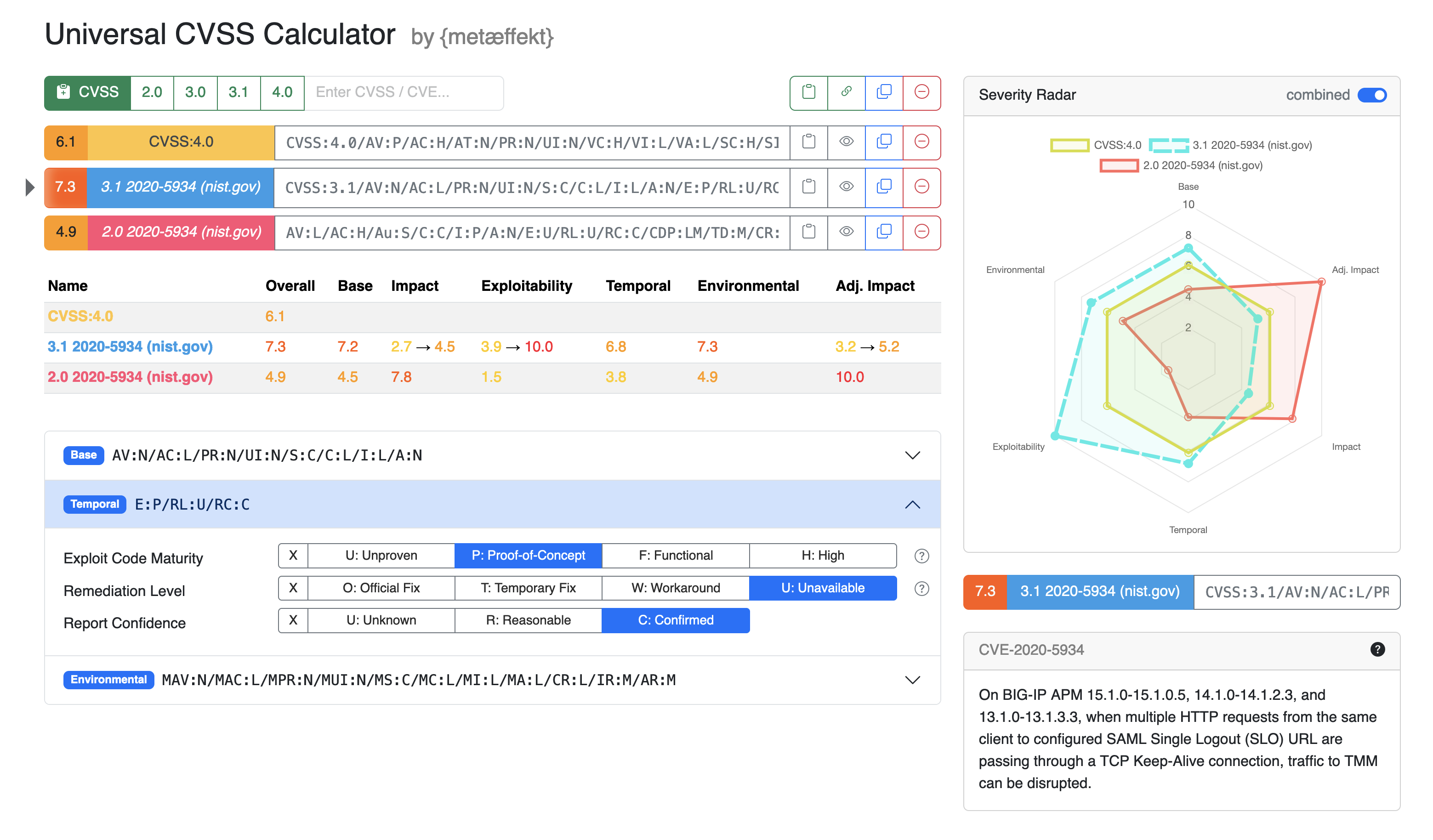The {metæffekt} CVSS Calculator (official online version) is a web application that allows to calculate CVSS scores for multiple CVSS vectors of different versions simultaneously. It is implemented in TypeScript and can be used as a library.
Available on NPM as ae-cvss-calculator and installable via:
npm install ae-cvss-calculatorSee README.md in the ae-cvss-calculator directory for instructions on how to build and
use the library.
- A UI implementation can be found in the site directory.
- The implementation is live on https://www.metaeffekt.com/security/cvss/calculator
- See the usage instructions in the UI to learn how to use the calculator.
The calculator supports the following URL parameters. Make sure to properly URL encode the values.
The vector parameter is a JSON array of JSON arrays. Each sub-array is of the following format:
[
"vector name",
true,
"CVSS:3.1/AV:N/AC:L/PR:N/UI:N/S:C/C:H/I:L/A:N",
"CVSS:3.1",
"CVSS:3.1/AV:A/AC:L/PR:N/UI:N/S:C/C:H/I:L/A:L"
]Where the first element is the name of the vector, the second element is a boolean indicating whether the vector is
visible, the third element is the CVSS vector string and the fourth element is the CVSS version string.
The CVSS version is one of CVSS:2.0, CVSS:3.1 or CVSS:4.0.
The optional fifth element (null by default) represents the initial vector that will be used to generate the
diff-vector when using the 'copy diff vector' button.
Example with a larger amount of vectors:
vector=[["CVSS:4.0",true,"CVSS:4.0/AV:P/AC:L/AT:N/PR:N/UI:N/VC:H/VI:L/VA:L/SC:H/SI:H/SA:H","CVSS:4.0","CVSS:4.0/AV:P/AC:L/AT:N/PR:N/UI:N/VC:H/VI:L/VA:L/SC:H/SI:H/SA:L"],["3.1+2020-5934+(nist.gov)",true,"CVSS:3.1/AV:N/AC:L/PR:L/UI:N/S:C/C:H/I:L/A:H/E:F/RL:U/RC:R","CVSS:3.1"],["2.0+2020-5934+(nist.gov)",true,"AV:L/AC:H/Au:S/C:C/I:P/A:N/E:U/RL:U/RC:C/CDP:LM/TD:M/CR:H/IR:H/AR:H","CVSS:2.0"]]
The open parameter is a string indicating which accordion elements are expanded.
They are normalized to a lowercase representation, where spaces are replaced by dashes - and individual elements are
separated by commas.
See the names of the individual categories for the possible values.
Example:
open=temporal,environmental-security-requirement
The selected parameter is a string indicating which vector is selected for editing.
If set, it must be the name of one of the vectors in the vector parameter.
Example:
selected=3.1+2020-5934+(nist.gov)
The cve parameter is a string indicating a comma separated list of CVE IDs.
If set, the calculator will automatically fetch the CVSS vectors from the NVD API and add them to the list of vectors.
Example:
cve=CVE-2020-5934,CVE-2020-5935
Using the NVD input field at the top of the editor, you can enter a CVE ID and the calculator will automatically fetch the CVSS vector(s) from the NVD API and add it to the list of vectors.
When selecting a vector sourced from the NVD, the according description will be displayed below the Severity Radar chart. This description is either fetched as part of the initial NVD API call or, if the vector was added via the URL parameter, fetched when selecting the vector.
